Lunar Retroreflectors
March 12, 2014
Today, there are likely as many
lenses in a
household as
mirrors. That's because every
smartphone and
tablet computer has a built-in
camera. There was a time, however, when a mirror might have been a household's only
optical device; at least in those households where the inhabitants had perfect
vision and didn't need
eyeglasses.
Mirrors
reflect light by
specular reflection. This means that the incoming and outgoing
light rays make the same
angle with respect to the mirror's
perpendicular direction, and these rays are
coplanar. We now have an explanation for this property, since it's a consequence of light being an
electromagnetic wave, but it was
experimentally demonstrated in the
1st century by
Hero of Alexandria. Hero was featured in
another article on the blog.
A retroreflector, unlike a mirror, has the property that it always reflects a ray back in the direction from which it came. The specular property of a combination of mirrors can be used to make a corner reflector retroreflector, as shown in the figure. In cases where the incoming ray is constrained to a narrow range of angles, the corner reflector can be truncated into a triangular corner reflector, also shown in the figure. I once used such a triangular corner reflector in a radar rangefinder, since they can be made to work for any electromagnetic radiation, not just light.
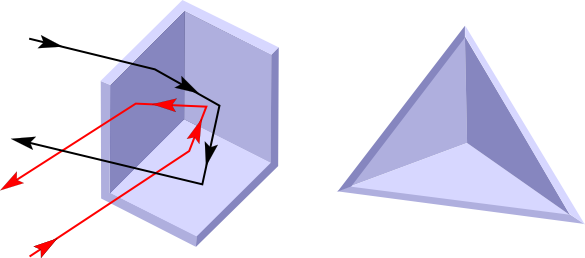
A corner reflector (left) and a triangular corner reflector (right). The specular reflection property of mirrors guarantees that a beam will reflect back to the source; of course, with a small offset. (Modified versions of a Wikimedia Commons image.)
After the United States won the space race by being the first to put astronauts on the moon, space had lost public support in both the US and the Soviet Union. These governments required spaceflight as a military tool, but they needed to sell spaceflight as a continuation of human exploration and on its scientific merits. To regenerate public interest, the two countries launched a joint mission in July, 1975, the Apollo–Soyuz Test Project.
I was a post doc in the chemistry department of the University of Pittsburgh at that time, and one of my department colleagues, Fred Kaufman (1919-1985), was co-investigator on an experiment on this mission. Kaufman is best known for showing the harmful effects of chlorofluorocarbons. The experiment used corner reflector retroreflectors.[1]
The retroreflectors were mounted on the Soyuz, the Soviet spacecraft on this mission. Their purpose was to reflect ultraviolet light from the american Apollo spacecraft through the rarefied atmosphere at their orbit to detect atomic oxygen and atomic nitrogen.[1] Oxygen and nitrogen are diatomic molecules at Earth's surface, but they exist in atomic form at high altitude because of photodissociation. Atomic oxygen is a corrosive agent in space.
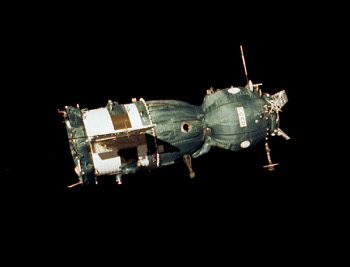
The Soyuz spacecraft, part of the July, 1975, Apollo–Soyuz Test Project.
(Portion of a NASA photograph, via Wikimedia Commons.)
Since there were only american investigators for this experiment, all apparatus except the retroreflectors were in the Apollo spacecraft. This included the UVA ultraviolet light source, which was locked to the retroreflector position by a star tracker, and a 0.75-meter spectrophotometer that scanned from 120.0 to 149.3 nm every 12 seconds with about 1 nm resolution. In the experiment, the distance between spacecraft was allowed to drift to obtain measurements at 150, 500, and 1000 meters separation.[1]
There were three retroreflectors mounted on the Soyuz, two of which were at the top of the spacecraft, one facing upwards and the other facing starboard. There was another aft of the vessel, pointing outwards. The experiment had planned to use the starboard retroreflector.[1] As an example of how experiments actually proceed, I quote from the report.
"For reasons still not understood, no clearly identifiable reflected ultraviolet radiation was detected during this pass."[1]
In the end, the Soyuz was rotated so that the aft retroreflector could be used.
The Apollo-Soyuz mission wasn't the first time that a retroreflector was placed in space. Retroreflectors have been placed at five locations on the Moon as a consequence of manned and unmanned landings there. The Apollo program placed three, starting in 1969, and the Soviet Union placed two that were integral to their unmanned Lunokhod rovers (see table).
The Lunar Laser Ranging Experiment uses the three Apollo retroreflectors and time-of-flight of laser pulses to accurately monitor the Earth-Moon distance. These experiments have found that the Moon is retreating from the Earth at about 3.8 centimeters per year. Significantly, these experiments shown that the gravitational constant ("Big-G") is constant to within one part in 1011 since 1969. Episode 23, Season 3 of The Big Bang Theory ("The Lunar Excitation") includes a laser ranging experiment from the Apollo 11 retroreflector.[2-3]
Astrophysicists have just solved a decades-old mystery of the Lunar Laser Ranging Experiment. Return signals from the lunar retroreflectors are significantly smaller around the time of a full moon.[4-5] In fact, the signals are ten time smaller than at other times, and the lunar rangers jokingly call this "the full-moon curse."[5] It predictably happens lunar month after lunar month, and the signal deficit, compounded with other losses, makes lunar ranging impossible for some observatories on full moon nights.[5]
Electrostatic charging leading to an accumulation of dust on the retroreflectors is likely responsible for a general degradation of the signal at all lunar phases. The data indicate a dust coverage of about 50%.[5] In laser ranging at Apache Point Observatory in New Mexico, a laser pulse of 100 quadrillion photons yields just a single return photon, or none at all.[5]
As for the full moon effect, that seems arise from a temperature gradient induced lensing in the retroreflectors when they're illuminated by the Sun. This hypothesis was tested by laser ranging through the lunar eclipse of December 21, 2010. Signals from the three Apollo retroreflectors and one Lunokhod retroreflector increased ten-fold during the 5-1/2 hour period of the eclipse.[5]
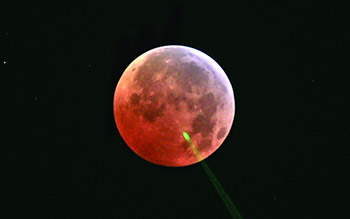
Laser ranging at a lunar eclipse.
The laser is visible as it illuminates high, thin clouds.
(Image: Jack Dembicky, Apache Point Observatory.)
![]()
References:
- T. M. Donahue, R. D. Hudson, W. T. Rawlins, J. Anderson, F. Kaufman and M. B. McElroyd , "Ultraviolet absorption: Experiment MA-059," NASA Technical Document 19780009153, January 1, 1977, PDF file via archive.org.
- The Big Bang Theory, Season 3, Episode 23, "The Lunar Excitation," May 24, 2010, Peter Chakos, Director, on the Internet Movie Database.
- Laser ranging clip from The Big Bang Theory, "The Lunar Excitation," on YouTube.
- T.W. Murphy Jr., R.J. McMillan, N.H. Johnson and S.D. Goodrow, "Lunar eclipse observations reveal anomalous thermal performance of Apollo reflectors," Icarus, vol. 231 (March 1, 2014), pp. 183-192.
- Susan Brown, "Source of ‘Moon Curse’ Revealed by Eclipse," University of California San Diego Press Release, February 6, 2014.
Permanent Link to this article
Linked Keywords: Lens; household; mirror; smartphone; tablet computer; camera; optics; optical device; vision; glasses; eyeglasses; reflection; light; specular reflection; light ray; angle; perpendicular; direction vector; coplanarity; coplanar; electromagnetic radiation; electromagnetic wave; experiment; 1st century; Hero of Alexandria; retroreflector; corner reflector; truncation; truncated; triangle; triangular; radar; rangefinder; Wikimedia Commons; United States; Space Race; astronauts on the moon; outer space; Soviet Union; government; spaceflight; military; exploration; science; scientific; country; Apollo–Soyuz Test Project; postdoctoral research; post doc; chemistry department; University of Pittsburgh; Fred Kaufman (1919-1985); chlorofluorocarbon; Soyuz spacecraft; ultraviolet light; Apollo spacecraft; atmosphere of Earth; orbit; atom; atomic; oxygen; nitrogen; diatomic molecule; lithosphere; Earth's surface; altitude; photodissociation; corrosion in space; scientific instrument; apparatus; UVA; star tracker; meter; spectrophotometry; spectrophotometer; nanometer; nm; starboard; aft; list of retroreflectors on the Moon; Apollo program; Lunokhod programme; Lunokhod rovers; Apollo 11; Apollo 14; Apollo 15; Lunokhod 1; Lunokhod 2; Lunar Laser Ranging Experiment; time-of-flight; laser; pulse; Earth; Moon; centimeter; gravitational constant; The Big Bang Theory, Episode 23, Season 3; astrophysics; Astrophysicist; decade; full moon; lunar month; observatory; electrostatic charging; lunar phase; data; laser ranging at Apache Point Observatory in New Mexico; photon; temperature gradient; Sun; hypothesis; lunar eclipse; cirrostratus cloud; high, thin cloud; Jack Dembicky, Apache Point Observatory.
 RSS Feed
RSS Feed
Google Search
Latest Books by Dev Gualtieri
Previews Available
at Tikalon Press
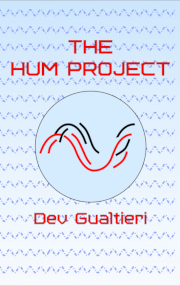
STEM-themed novel for middle-school students


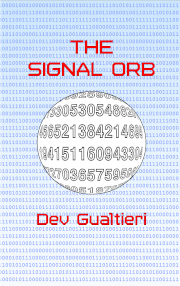
Mathematics-themed novel for middle-school students


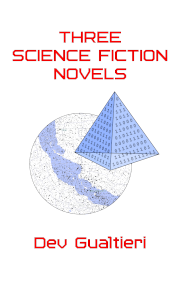
Complete texts of LGM, Mother Wode, and The Alchemists of Mars

Other Books
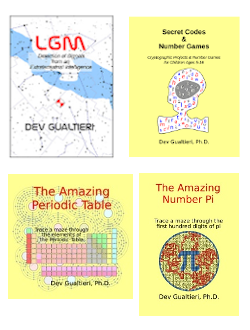
Blog Article Directory on a Single Page
Recent Articles
- Green Ammonia, July 22, 2024
- Cold Brew Coffee, July 15, 2024
- US Independence Day, July 4, 2024
- Copper and Green Energy, July 1, 2024
- Baseball Mud, June 24, 2024
- Wiedemann-Franz Law, June 17, 2024
- A.I., Wine, and Beer, June 10, 2024
- Bergmann's rule, June 3, 2024
- 60 Hertz Standard, May 27, 2024
- Droplets, May 20, 2024
- Levitation, May 13, 2024
- 100 Years of IBM, May 6, 2024
- Cicada Apocalypse, April 29, 2024
- Critical Materials, April 22, 2024
- Eclipse 2024, April 15, 2024
- Reverse Sprinkler, April 8, 2024
- T Coronae Borealis, April 1, 2024
- Coffee and Tea, March 25, 2024
- Arno Penzias (1933-2024), March 18, 2024
- Wave-Particle Duality, March 11, 2024
- Offshore Wind, March 4, 2024
- High Entropy Ceramics, February 26, 2024
- Methane Emissions, February 19, 2024
- Thales, Heron, and Experimental Mathematics, February 12, 2024
- Mica, February 5, 2024
- Disk Packing, January 29, 2024
- Is eπ > πe?, January 22, 2024
- Brownian Motion Energy Harvesting, January 15, 2024
- Coin Flip, January 8, 2024

Deep Archive
Deep Archive 2006-2008
